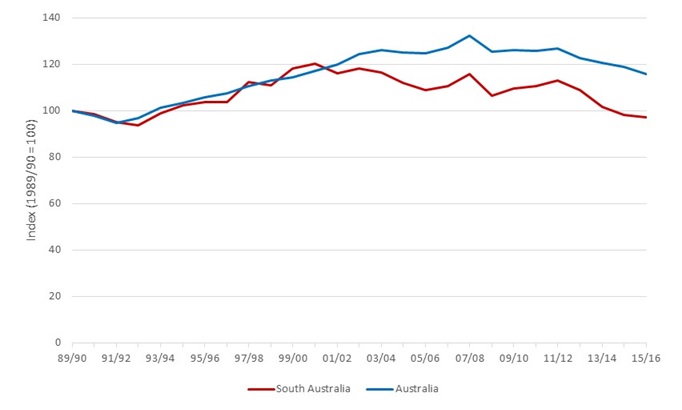The manufacturing sector has historically been of moderately greater importance to the South Australian economy than the national economy. One of the characteristic features of South Australia’s more recent economic development is that this relatively greater importance of manufacturing has now almost completely disappeared.
Figure 1 show the manufacturing sector’s share of South Australian gross state product and corresponding Australian gross domestic product from 1989/90 to 2015/16. Over much of this period the manufacturing sector’s share of the South Australian economy remained a few percentage points above the national average. However, this excess share has fallen sharply over the past decade, from 3.1 per cent in 2006/07 to just 0.6 per cent in 2015/16. This narrowing has been particularly acute since the Global Financial Crisis.
Thus the South Australian economy now much more closely resembles the national economy in terms of its propensity for manufacturing. In this sense it cannot be considered a “manufacturing state”. Nonetheless, the state has strengths in certain areas of manufacturing, such as food and beverage processing, defence, water-related products, automation, and medical equipment.
Figure 1: Manufacturing sector value added as a proportion of Gross State/Domestic Product

Source: ABS, Statistics, National Accounts.
Another notable characteristic of medium term trends for manufacturing in South Australia is that the sector has also declined in aggregate terms over the past decade – see Figure 2. Total real gross value added for manufacturing in South Australia in 2015/16 was down 19 per cent compared to its peak in 2000/01. In comparison, national manufacturing value added was down just 1.1 per cent over this period. Clearly the state has experienced a significant contraction in manufacturing activity over the past decade.
It is beyond the scope of this post to examine in detail the causes of the relatively large decline in manufacturing in South Australia. To put it briefly it would reflect various factors including, but not limited to, the historical importance of motor vehicle manufacturing in the state which has effectively collapsed; adverse competitive effects associated with the previously elevated exchange rate and pressure on input prices during the mining boom; impact of globalisation, which has placed greater emphasis on natural endowments as a means of differentiating production and comparative trade advantage; shifting consumer tastes; lower labour productivity; and various industry specific factors.
Figure 2: Index of manufacturing sector real gross value added, South Australia and Australia

Source: ABS, Statistics, National Accounts.
The decline in the manufacturing sector in both aggregate and relative terms has occurred despite significant government subsidies and supports targeted at the sector. The substantial decline in manufacturing production points to the limitations of industry policy. Of course, it is possible that manufacturing production would have fallen even further in the absence of these supports. However, significant ongoing support has not prevented certain sectors, such as motor vehicle manufacturing, from collapsing.
The recent experience for manufacturing suggests that government policy in respect of economic development should take a more industry-agnostic approach in future, focusing on activities that are likely to benefit a broader range and type of businesses. Relevant examples would include providing high quality infrastructure; facilitating reliable and efficient utility services; investing in high level technical skills; providing quality education and training services; minimising regulatory burdens; providing a competitive tax environment; and ensuring efficient delivery of public services. Such an approach should not preclude industry or region specific policy interventions from being adopted to help people and businesses cope during periods of significant adjustment (e.g. support for motor vehicle industry workers to help them transition to alternative employment).
